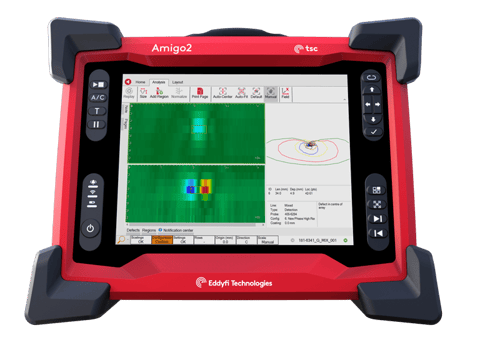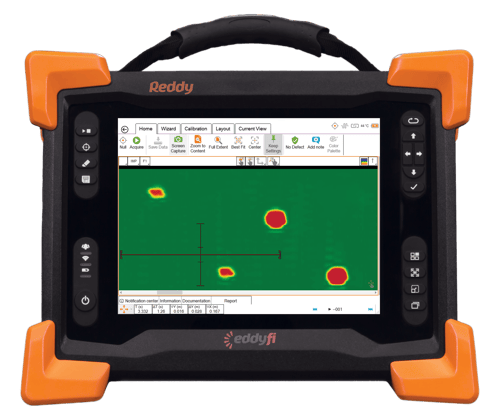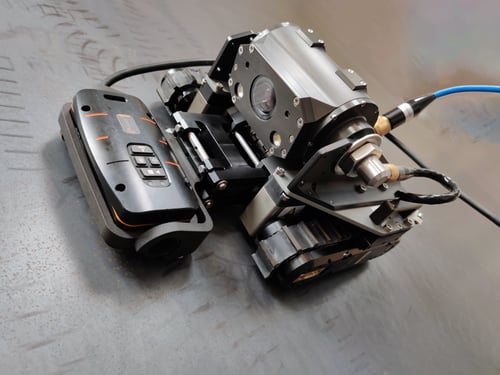This non-destructive testing method introduces an alternating current into the test surface in order to identify surface-breaking cracks. Compared to conventional inspection methods ACFM is extremely fast and while sophisticated, it is surprisingly easy to apply. Offering a high Probability of Detection (PoD), ACFM results are reliable with immediate defect sizing and recording as major benefits. The electromagnetic testing technique continues to prove an ideal method for the detection and measurement of surface cracks in metals through coatings; ACFM has a successful track record for assessing civil structures such as cranes, marine vessels, wind turbines, and bridges. The technique remains quick and easy to deploy for underwater inspection, particularly applicable for submerged regions of bridgework.
%20(Large)-1.jpg?width=500&name=ACFM_Rotterdam%20(6%20of%207)%20(Large)-1.jpg)
Given its versatility and strength, galvanized steel is commonly used for bridge construction projects; however, the conductive coating introduces new challenges for structural integrity assessments. There are two constraints to consider when it comes to employing ACFM for inspecting galvanized steel bridgework for surface-breaking defects:
-
The coating thickness should not exceed 500 microns according to the recommended ACFM Practice 1449,
-
The surface condition of the coating at inspection must be closely observed as badly flaking or extremely uneven coatings can cause excessive noise signals which makes seeing underlying defect signals difficult.
While length measurements using ACFM are accurate, depth sizing may be affected by the thickness of the conductive coating. Evaluation of the coating thickness at the location of the detected cracks in the bridge may prove a challenging process; therefore, it is recommended that the coating be removed prior to sizing the cracks.
What about cracks occurring beneath the galvanization, i.e., cracks that break through the surface of the steel without breaking through the coating? Numerical simulation and theoretical analysis of ACFM signals have shown that the technique can successfully detect this type of cracking under a few conditions. The coating should not exceed 300 microns, higher than the recommended galvanization thickness for most applications. Most applications will have a coating thickness that is less than 200 microns, especially when hot dipping is used. When trying to deploy conventional techniques like Magnetic Particle Inspection (MPI) in situations where the coating thickness exceeds 100 microns, the dissolved iron underneath the coating layer can affect the magnetic particle patterns. When a thermally sprayed aluminum is used, the recommended coating thickness is 200 to 350 microns, and if the coating is not well controlled it can reach up to 500 microns. Because ACFM requires a uniform coating without flakes or uneven coating, inspection may be challenging under this scenario the same way it is for other conventional methods.
Amigo™ 2 ACFM® Instrument by Eddyfi Technologies
With NDT, there’s advantages and disadvantages to each technique and that’s why Eddyfi Technologies is committed to offering a comprehensive portfolio to address all client requirements. If you’re a proud Reddy® owner then you may already be applying the eddy current array, or ECA, technique to bridge inspections like a client who inspected the famous Memphis bridge. While ACFM is desirable for assessing a bridge’s structural welds, ECA offers a unique solution for the detection of cracks through the concrete or asphalt. The structural integrity of steel bridge structures may be compromised from the infiltration of water in the deck through cracks here. Water infiltration is a vessel for chlorides and various debris that will induce corrosion in the steel structure underlying the road. Although corrosion does not represent a threat by itself, when combined with extreme environmental conditions and tensile stress in the steel, it can lead to the development of stress corrosion cracking. Despite being rare in steel bridge structures, occurrences of stress corrosion cracking should not be neglected since they can lead to the sudden, non-ductile failure of otherwise ductile bridge decks.
 Reddy® Surface ECA and MFL Instrument by Eddyfi Technologies
Reddy® Surface ECA and MFL Instrument by Eddyfi Technologies
Moreover, with Eddyfi Technologies standard offering of robotics for non-destructive testing, the risks surrounding work at heights is minimized or eliminated for bridge inspectors. The Magg™ enabled robotic crawler can be paired with both our ACFM and tangential eddy current array, or TECA™, technology found in the Sharck™ for actionable data collection from high or low bridge locations – no dangerous rope access necessary.
Forget about the straw that broke the camel’s back. It’s time to raise the quality level of bridge inspections with commercially available technology that can help ensure the infrastructure’s continued safe use. Contact our team to discuss better bridge management today.
Authors: Ahmed Sweedy, Charles Tremblay, Mathieu Bouchard





